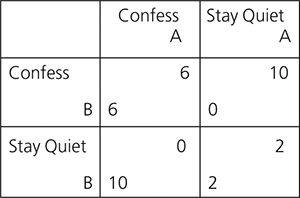The classic problem in game theory. Two prisoners jointly charged with a crime are held apart, and each is given the option of confessing, or not confessing. If each confesses, he convicts them both, and they will serve six years each. If neither confesses, the prosecutor will find a lesser charge, and each will serve two years. If A confesses and B does not, A is released and B serves an aggravated ten years. If B confesses and A does not, B is released, and A serves an aggravated ten years. The matrix is shown in the figure:

The surprising truth about the game is that whatever the other prisoner does a prisoner does better by confessing (if A confesses, B does better for himself by confessing, and if A does not confess, B does better for himself by confessing; and conversely for A if B confesses or does not confess). Confessing dominates not confessing. Yet the social result in which each of A and B follows this reasoning is the worst of all (12 person-prison years) and together they would have done much better by sitting tight (4 person-prison years). Many political situations (e.g. whether to vote when there is a cost to doing so, whether to refrain from wage bargaining, whether to be a good citizen and turn off one’s hose during a water shortage) can be modelled as prisoners’ dilemmas. The structure shows that it is not always the case that the social good is furthered efficiently by each person doing what is in his or her own best interests: as well as an ‘invisible hand’ whereby unbridled self-interest elevates everybody’s position, there can be an invisible boot whereby it diminishes it (see Smith).
An iterated prisoners’ dilemma is a sequence of such situations, of either finite or infinite length. In an interesting study (The Evolution of Cooperation, 1984) Robert Axelrod showed that an efficient policy in such a situation is ‘tit for tat’: you start off co-operating (not confessing) until faced with a play on which the opponent confesses, and then you confess once in retaliation, but then, if the opponent mends his ways, you go back to not confessing until the same thing happens again. As well as being an efficient strategy ‘tit for tat’ has some intuitive moral justification. However, the strategy is sensitive to the ratio of rewards and penalties that are in play, and cannot be said to be the single best strategy for all circumstances. See also assurance game; chicken; commons, tragedy of.
http://www.univie.ac.at/virtuallabs/Introduction/pd.html An online tutorial on the prisoners’ dilemma
http://www.gametheory.net/applets/prisoners.html Simulations of the prisoners’ dilemma
A two-player game that illustrates the conflict between private and social incentives, and the gains that can be obtained from making binding commitments. The name originated from a situation of two prisoners who must each choose between the strategies ‘Confess’ and ‘Don’t confess’ without knowing what the other will choose. The important feature of the game is that a lighter penalty follows for a prisoner who confesses when the other does not. The game is summarized in the pay-off matrix where the negative pay-offs can be interpreted as the disutility from imprisonment.

The Nash equilibrium of the game is {Confess, Confess}. The interesting feature is that this equilibrium is not Pareto efficient: the pay-off of both players would be higher if they played {Don’t confess, Don’t confess}. However, if one player chose Don’t confess then it is individually rational for the other player to choose Confess. Without a device for making a binding commitment it is not possible for {Don’t confess, Don’t confess} to be an equilibrium.
- ACK signal
- ACL
- aclinic line
- ACM
- acme zone
- acnode
- acoelomate
- acosmism
- acoustic basement
- acoustic coupler
- acoustic delay line
- acoustic feedback
- acoustic impedance
- acoustic memory
- acoustic pressure waveform
- acoustics
- acoustic wave
- acoustic wave device
- acoustoelectronic devices
- acquaintance and description
- acquiescence bias
- acquired characteristics
- acquired immune deficiency syndrome
- acquired immunity
- acquiring bank